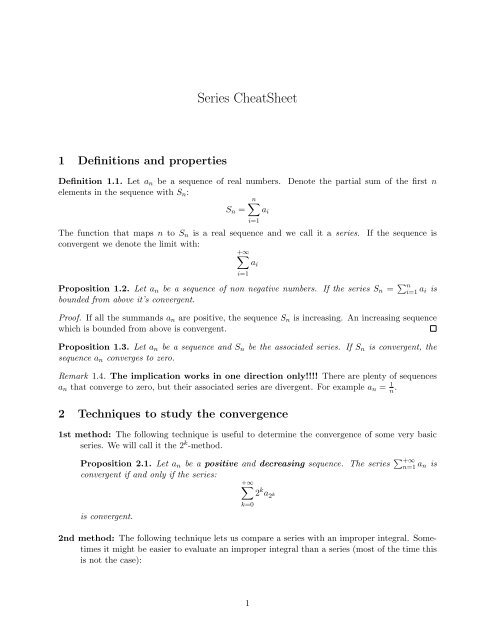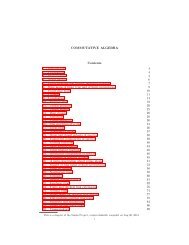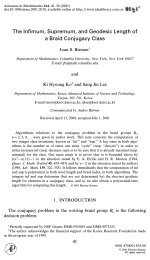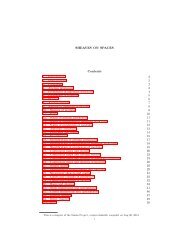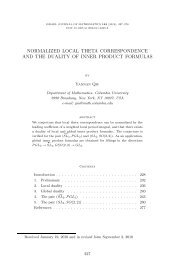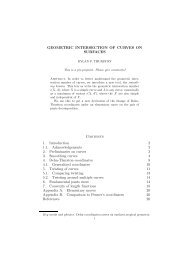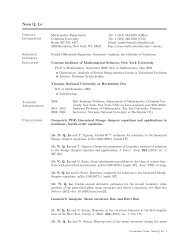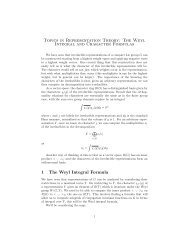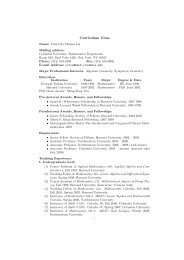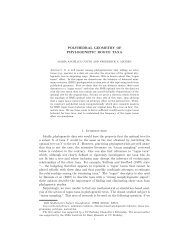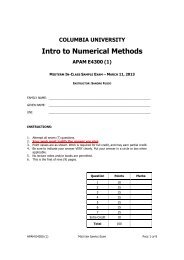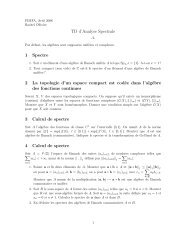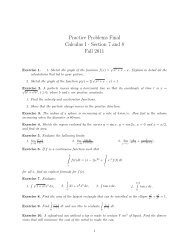Series CheatSheet
Series CheatSheet
Series CheatSheet
You also want an ePaper? Increase the reach of your titles
YUMPU automatically turns print PDFs into web optimized ePapers that Google loves.
1 Definitions and properties<br />
<strong>Series</strong> <strong>CheatSheet</strong><br />
Definition 1.1. Let an be a sequence of real numbers. Denote the partial sum of the first n<br />
elements in the sequence with Sn:<br />
n<br />
Sn =<br />
The function that maps n to Sn is a real sequence and we call it a series. If the sequence is<br />
convergent we denote the limit with:<br />
+∞<br />
i=1<br />
Proposition 1.2. Let an be a sequence of non negative numbers. If the series Sn = n<br />
i=1 ai is<br />
bounded from above it’s convergent.<br />
Proof. If all the summands an are positive, the sequence Sn is increasing. An increasing sequence<br />
which is bounded from above is convergent.<br />
Proposition 1.3. Let an be a sequence and Sn be the associated series. If Sn is convergent, the<br />
sequence an converges to zero.<br />
Remark 1.4. The implication works in one direction only!!!! There are plenty of sequences<br />
an that converge to zero, but their associated series are divergent. For example an = 1<br />
n .<br />
2 Techniques to study the convergence<br />
1st method: The following technique is useful to determine the convergence of some very basic<br />
series. We will call it the 2 k -method.<br />
i=1<br />
ai<br />
Proposition 2.1. Let an be a positive and decreasing sequence. The series +∞<br />
n=1 an is<br />
convergent if and only if the series:<br />
+∞<br />
2 k a2k is convergent.<br />
k=0<br />
2nd method: The following technique lets us compare a series with an improper integral. Sometimes<br />
it might be easier to evaluate an improper integral than a series (most of the time this<br />
is not the case):<br />
1<br />
ai
Proposition 2.2. Let f(x) be a real function on the interval [1, +∞) which is positive,<br />
continuous and decreasing. Let n be a natural number, the following inequality holds:<br />
n+1<br />
1<br />
f(x) dx ≤<br />
n<br />
f(i) ≤<br />
i=1<br />
n+1<br />
1<br />
f(x) dx + f(1) − f(n)<br />
The series +∞<br />
i=1 f(i) is convergent if and only if the improper integral +∞<br />
1 f(x) dx is convergent.<br />
3rd method: With the following proposition we can compare a given series with some other series<br />
that we have already studied:<br />
Proposition 2.3. Let an, bn be two positive sequences. Suppose that there is a natural number<br />
n such that for all n > n the following inequality holds:<br />
an ≤ bn<br />
Under these assumptions if the series +∞<br />
n=1 bn is convergent, the series +∞<br />
n=1 an is also<br />
convergent. If the series +∞<br />
n=1 an is divergent, the series +∞<br />
n=1 bn is also divergent.<br />
4th method: The following technique is the basic tool to turn a complicated series into something<br />
simpler. It’s not the ultimate technique (there are cases where it’s inconclusive) but it’s the<br />
sharpest tool that we have (for the moment).<br />
Proposition 2.4. Let an, bn be positive sequences. Suppose that the sequence bn converges to<br />
a real number C > 0. The series +∞<br />
n=1 anbn is convergent if and only if the series +∞<br />
n=1 an<br />
is convergent.<br />
If the limit of bn is zero we have a weaker statement:<br />
Proposition 2.5. Let an, bn be positive sequences. Suppose that the sequence bn converges<br />
to zero. If the series +∞<br />
n=1 an is convergent, the series +∞<br />
n=1 anbn is also convergent.<br />
3 Fundamental limits<br />
The following limits of sequences are fundamental. These should be used together with the limit<br />
comparison technique.<br />
•<br />
•<br />
•<br />
•<br />
lim<br />
n→+∞<br />
lim<br />
n→+∞<br />
lim<br />
n→+∞<br />
sin 1<br />
n<br />
1<br />
n<br />
1 − cos 1<br />
n<br />
1<br />
n 2<br />
= 1<br />
= 1<br />
2<br />
ln(1 + 1<br />
n )<br />
1 = 1<br />
n<br />
e<br />
lim<br />
n→+∞<br />
1<br />
n − 1<br />
1 = 1<br />
n<br />
2
4 Strategy<br />
There is no algorithm to determine the convergence of a series, nonetheless we can try to outline a<br />
strategy that would work in many circumstances.<br />
Step 1: If the sequence an doesn’t converge to zero the series is divergent and we are done.<br />
Step 2: If the limit is zero the series can be convergent divergent or might not have a limit.<br />
If possible, we apply limit comparison repeatedly to replace transcendental functions<br />
with rational functions. We replace in the following way:<br />
•<br />
•<br />
•<br />
•<br />
sin 1 1<br />
≈<br />
n n<br />
cos 1 1<br />
≈ 1 −<br />
n 2n2 ln(1 + 1 1<br />
) ≈<br />
n n<br />
e 1<br />
n ≈ 1 + 1<br />
n<br />
If after replacing the transcendental pieces the sequence is equal to zero, limit comparison<br />
is inconclusive!!!<br />
Step 3: If the sequence is an algebraic function (polynomials, divisions and radicals only) we<br />
collect the highest power of n and we apply limit comparison again.<br />
Step 4: If everything worked fine the series should be a fundamental series (one in the list<br />
below) or more in general a product/quotient of the following functions: n p , a n , ln q (n), n!, n n . At<br />
this point we can try to conclude the calculation using the integral test, the 2 k -test or comparison.<br />
Example 4.1. Determine for which positive real numbers α, β the following series is convergent:<br />
+∞<br />
n=1<br />
<br />
1<br />
sin<br />
nβ <br />
ln α (n 2 + 1)<br />
We apply limit comparison and replace sin and we obtain the following equivalent series:<br />
+∞<br />
n=1<br />
We extract the leading term from the logarithm:<br />
+∞<br />
n=1<br />
1<br />
n β lnα (n 2 + 1)<br />
1<br />
nβ <br />
2 ln(n) + ln 1 + 1<br />
n2 α We don’t need to approximate ln 1 + 1<br />
n2 <br />
since we are summing it to ln(n) which is divergent. We<br />
apply limit comparison again:<br />
+∞ (ln(n)) α<br />
n=2<br />
3<br />
n β
This series cannot be made any simpler. We can try to apply the 2 k -test and we obtain:<br />
+∞<br />
n=1<br />
n α<br />
2 n(1−β)<br />
We conclude by comparing with the improper integral:<br />
+∞<br />
It becomes more familiar if we replace 2 with e:<br />
+∞<br />
1<br />
1<br />
x α 2 x(1−β) dx<br />
x α e x(1−β) ln(2) dx<br />
If β − 1 > 0 we can make the substitution t = x(β − 1) ln(2) and we obtain:<br />
+∞<br />
x<br />
(β−1) ln(2)<br />
α e −x dx<br />
which is convergent for every value of α. The series is convergent for β > 1 and α > 0 and not<br />
convergent for 0 < β ≤ 1 and any value of α. We could have skipped the 2 k -test and apply the<br />
integral test directly (this second approach is not any simpler).<br />
5 Fundamental series<br />
The following series should be considered fundamental, and you don’t have to retrieve them each<br />
time you do a calculation:<br />
•<br />
•<br />
•<br />
•<br />
+∞<br />
n=1<br />
It is convergent if and only if p > 1. It can be retrieved with the integral test or the 2 k -test.<br />
It is convergent if and only if |p| < 1. It can be calculated explicitly.<br />
+∞<br />
n=1<br />
+∞<br />
n=1<br />
1<br />
n p<br />
p n<br />
1<br />
n(ln(n)) p<br />
It is convergent if and only if p > 1. It can be retrieved with the integral test or the 2 k -test.<br />
+∞<br />
n=1<br />
It is convergent. It can be done by comparison.<br />
4<br />
n!<br />
n n
•<br />
•<br />
•<br />
It is convergent. Done by comparison.<br />
It is convergent for every p. It can be retrieved with the integral test.<br />
+∞<br />
n=1<br />
+∞<br />
n=1<br />
+∞<br />
n=1<br />
e n<br />
n!<br />
n p<br />
e n<br />
ln(n)<br />
n p<br />
It is convergent if and only if p > 1. It can be retrieved with the integral test or the 2 k -test.<br />
The number p in all the previous formulas is a real number.<br />
6 Good but not optimal estimate of the factorial<br />
Sometimes it’s useful to compare the factorial with some better looking function. We start from<br />
the identity:<br />
n<br />
ln(n!) = ln(i)<br />
Since ln is monotonic (increasing) we can compare with the integral:<br />
n<br />
1<br />
ln(x) dx ≤<br />
i=1<br />
n<br />
ln(i) ≤<br />
i=1<br />
n+1<br />
1<br />
ln(x) dx<br />
We can integrate the logarithm and we have:<br />
n<br />
n ln(n) − n + 1 ≤ ln(i) ≤ (n + 1) ln(n + 1) − n<br />
We can now remove the logarithm by exponentiating the inequality:<br />
i=1<br />
nn (n + 1)n+1<br />
≤ n! ≤<br />
en−1 en Example 6.1. Determine if the series is convergent or divergent:<br />
Applying the estimate we have:<br />
Since the series +∞<br />
n=1<br />
well.<br />
+∞<br />
n=1<br />
3 n n!<br />
n n<br />
3n en−1 ≤ 3nn! nn ≤ 3n (n + 1) n+1<br />
nnen n 3<br />
e is divergent, by comparison the series we are studying is divergent as<br />
5
This estimate is good enough for many applications but it’s not optimal since:<br />
lim<br />
n→+∞<br />
This means that n! is not approximated by<br />
can be proven that:<br />
lim<br />
n→+∞<br />
n!<br />
n = +∞<br />
n<br />
e<br />
n n<br />
e . However, by some more advanced technique it<br />
n!<br />
√ 2πn<br />
n<br />
e<br />
n = 1<br />
This means that for large values of n the factorial is approximated by √ 2πn<br />
as Stirling’s formula and it goes beyond the purpose of these notes.<br />
6<br />
<br />
n<br />
e<br />
n<br />
. This is known


